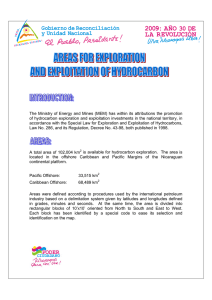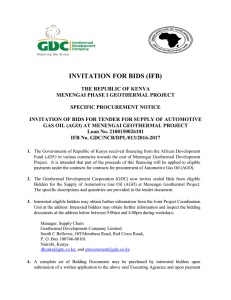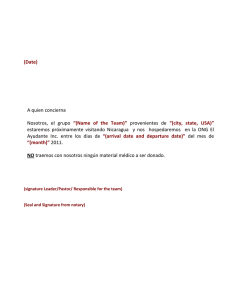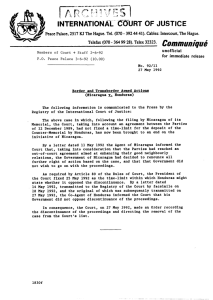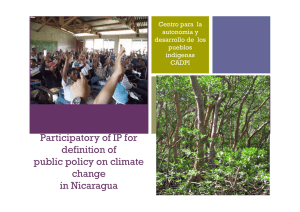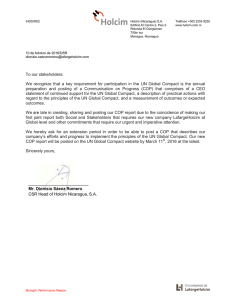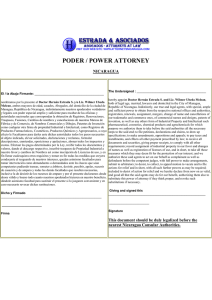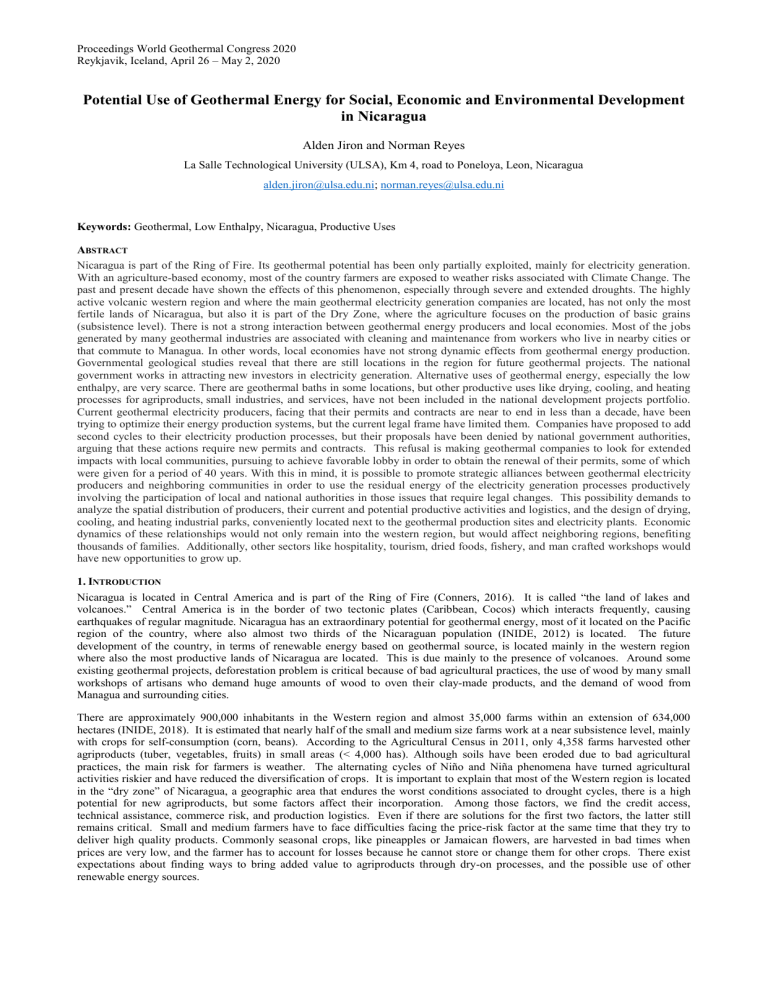
Proceedings World Geothermal Congress 2020 Reykjavik, Iceland, April 26 – May 2, 2020 Potential Use of Geothermal Energy for Social, Economic and Environmental Development in Nicaragua Alden Jiron and Norman Reyes La Salle Technological University (ULSA), Km 4, road to Poneloya, Leon, Nicaragua [email protected]; [email protected] Keywords: Geothermal, Low Enthalpy, Nicaragua, Productive Uses ABSTRACT Nicaragua is part of the Ring of Fire. Its geothermal potential has been only partially exploited, mainly for electricity generation. With an agriculture-based economy, most of the country farmers are exposed to weather risks associated with Climate Change. The past and present decade have shown the effects of this phenomenon, especially through severe and extended droughts. The highly active volcanic western region and where the main geothermal electricity generation companies are located, has not only the most fertile lands of Nicaragua, but also it is part of the Dry Zone, where the agriculture focuses on the production of basic grains (subsistence level). There is not a strong interaction between geothermal energy producers and local economies. Most of the jobs generated by many geothermal industries are associated with cleaning and maintenance from workers who live in nearby cities or that commute to Managua. In other words, local economies have not strong dynamic effects from geothermal energy production. Governmental geological studies reveal that there are still locations in the region for future geothermal projects. The national government works in attracting new investors in electricity generation. Alternative uses of geothermal energy, especially the low enthalpy, are very scarce. There are geothermal baths in some locations, but other productive uses like drying, cooling, and heating processes for agriproducts, small industries, and services, have not been included in the national development projects portfolio. Current geothermal electricity producers, facing that their permits and contracts are near to end in less than a decade, have been trying to optimize their energy production systems, but the current legal frame have limited them. Companies have proposed to add second cycles to their electricity production processes, but their proposals have been denied by national government authorities, arguing that these actions require new permits and contracts. This refusal is making geothermal companies to look for extended impacts with local communities, pursuing to achieve favorable lobby in order to obtain the renewal of their permits, some of which were given for a period of 40 years. With this in mind, it is possible to promote strategic alliances between geothermal electricity producers and neighboring communities in order to use the residual energy of the electricity generation processes productively involving the participation of local and national authorities in those issues that require legal changes. This possibility demands to analyze the spatial distribution of producers, their current and potential productive activities and logistics, and the design of drying, cooling, and heating industrial parks, conveniently located next to the geothermal production sites and electricity plants. Economic dynamics of these relationships would not only remain into the western region, but would affect neighboring regions, benefiting thousands of families. Additionally, other sectors like hospitality, tourism, dried foods, fishery, and man crafted workshops would have new opportunities to grow up. 1. INTRODUCTION Nicaragua is located in Central America and is part of the Ring of Fire (Conners, 2016). It is called “the land of lakes and volcanoes.” Central America is in the border of two tectonic plates (Caribbean, Cocos) which interacts frequently, causing earthquakes of regular magnitude. Nicaragua has an extraordinary potential for geothermal energy, most of it located on the Pacific region of the country, where also almost two thirds of the Nicaraguan population (INIDE, 2012) is located. The future development of the country, in terms of renewable energy based on geothermal source, is located mainly in the western region where also the most productive lands of Nicaragua are located. This is due mainly to the presence of volcanoes. Around some existing geothermal projects, deforestation problem is critical because of bad agricultural practices, the use of wood by many small workshops of artisans who demand huge amounts of wood to oven their clay-made products, and the demand of wood from Managua and surrounding cities. There are approximately 900,000 inhabitants in the Western region and almost 35,000 farms within an extension of 634,000 hectares (INIDE, 2018). It is estimated that nearly half of the small and medium size farms work at a near subsistence level, mainly with crops for self-consumption (corn, beans). According to the Agricultural Census in 2011, only 4,358 farms harvested other agriproducts (tuber, vegetables, fruits) in small areas (< 4,000 has). Although soils have been eroded due to bad agricultural practices, the main risk for farmers is weather. The alternating cycles of Niño and Niña phenomena have turned agricultural activities riskier and have reduced the diversification of crops. It is important to explain that most of the Western region is located in the “dry zone” of Nicaragua, a geographic area that endures the worst conditions associated to drought cycles, there is a high potential for new agriproducts, but some factors affect their incorporation. Among those factors, we find the credit access, technical assistance, commerce risk, and production logistics. Even if there are solutions for the first two factors, the latter still remains critical. Small and medium farmers have to face difficulties facing the price-risk factor at the same time that they try to deliver high quality products. Commonly seasonal crops, like pineapples or Jamaican flowers, are harvested in bad times when prices are very low, and the farmer has to account for losses because he cannot store or change them for other crops. There exist expectations about finding ways to bring added value to agriproducts through dry-on processes, and the possible use of other renewable energy sources. Alden Jiron and Norman Reyes In order to promote the direct use of geothermal low-enthalpy resources, it is required to evaluate the social context where the projects would be located. This document has the purpose of presenting an exploratory analysis of the main factors required to implement a low-enthalpy geothermal project in the countryside of the Western region of Nicaragua, focusing on drying services mainly. Survey data was collected through interviews to farm owners or their relatives when they were absent. All the visited farms are located in a radius of 40 km surrounding the thermal sources of San Jacinto, municipality of Telica, in the Department of Figure 1. Western Region Roads Map with the cities of Leon and Chinandega (Source: Public data, own made) Leon. 2. GEOTHERMAL POTENTIAL OF NICARAGUA Nicaragua has a high geothermal potential not yet developed. This resource is located on the Pacific coast and mainly in the Western zone. In Table 1 (below), which is based on official data coming out from the Ministry of Energy and Mines sources (MEM, 2019) it can be observed that only water sources outperform geothermal sources in already known generation potential. The same table shows that less than 10% of the known potential is in use and it is expected that investments in this sector would not achieve the 20% of its potential by 2027. This table only reflects the potential in electricity generation with medium and high enthalpy, leaving out the thermal generation potential in low enthalpy. Table 1. Situation of Electricity Generation Sources in Nicaragua up to year 2018 Generating Resource Operating (MW) Developing (MW) Hired Capacity (MW) 177 249.3 142 448.57 25.38 863.7 1905.95 Biomass* 139 38 Eolic 186.6 62.7 Geothermal 142 0 Hydro 146.97 301.6 Solar** 13.38 12 Fossil 863.7 0 TOTAL 1491.65 414.3 * It does not include sources as biogas and biofuels ** It does not include home / commercial autonomous systems Source: (Proyecto UNSEWN 2, 2018) Goal 2013 - 2027 (MW) 114 40 131 737 0 140 1162 Country Potential (MW) 300 800 1500 2100 1000 5700 To Hire (MW) % Remaining Potential 9 550.7 1227 914.43 974.62 3.00% 68.80% 81.80% 43.50% 97.50% 3675.75 64.50% 2.1 Current Geothermal Infrastructure (High Enthalpy) In Nicaragua, only two companies are working on the generation of electricity with geothermal sources. Both companies are located in the department of León. Momotombo Power Company (MPC), located on the slopes of the Momotombo volcano, manages the Momotombo geothermal plant that has a proven capacity of 70 megawatts, but it only generates 22 MW (Piensa en Geotermia, 2013); and Polaris Energy of Nicaragua (PENSA) owned by the Canadian company Polaris Energy Inc. which is located in the proximity of Telica volcano and has the San Jacinto-Tizate geothermal plant with a potential of 87 megawatts (PENSA, 2019). Momotombo geothermal plant, owned by MPC, is the oldest plant in the country, entered service in 1983 with an installed capacity of 35 MW. Its power capacity was later increased by another 35 MW in 1989. The reservoir was not managed properly and in 1992, it the declining of the plant began (El Nuevo Diario, 2009). In 2002, Ormat Technologies Inc. through its subsidiary Ormat 2 Alden Jiron and Norman Reyes Holding Corp., became responsible for the operation of the Momotombo Plant with a starting initial capacity of 8 MW (ORMAT, 2019). In 2013, when they sold its shareholding to the companies DISNORTE-DISSUR, Ormat had increased the generation capacity to 22 MW (Piensa en Geotermia, 2013). Polaris Energy Nicaragua S.A (PENSA) operates and owns the San Jacinto-Tizate Geothermal Plant, with an installed capacity of 77 MW (72 MW net). This company continued the work started by Intergeoterm, a public-private capital company owned by Nicaraguan Electricity Company (ENEL) (77%) and Burgazgeoterm (23%), a Russian subsidiary of Gazprom (PENSA, 2019). It is estimated that the actual operating levels of the San Jacinto-Tizate plant are on the order of 60 MW average. 2.2 Vision of Geothermal Projects (High Enthalpy) As previously stated, there are not many ongoing geothermal projects for Nicaragua. Despite the fact that the Government has made roadshows to promote investment in this sector, especially in Germany, where they did several presentations in 2017. There are currently only two underway projects, one in progress and the other one under study. The first is Proyecto Casitas - San Cristobal. This project is a case of public-private partnership in the geothermal sector. The company is called Cerro Colorado Power S.A., and its shareholders are ENEL and Polaris Infrastructure Inc. This geothermal project aims to install a plant with a capacity of 35 MW. The phase of social and environmental study was completed in 2017 (ENEL, 2017). In the same year, they initiated the phase of technical analysis of the resource for exploitation. The second project still in the study phase, is the Exploration of the Cosigüina Volcanic Geothermal Field, which began in 2017 and it is estimated to end in 2022. The studies include the drilling of wells, validation of pre-feasibility studies and the risk mitigation analysis (MEM, 2019). The Expansion Plan of the Geothermal Generation 2019-2033 (EPGG) (MEM, 2018), shows that Government plans are to establish 18 geothermal projects, of 25 - 35 MW capacity, to start operations between the year 2027 and 2032. The EPGG does not show more information about the sites where potentialities have been identified, but it is estimated that all projects would add 550 MW with a value of US $ 4.7 million per installed MW. In consultation with the governmental agency PRONICARAGUA, it was determined that all the projects contemplated in the EPGG are open to external financing, but they only mention those that would be located in the Mombacho volcano and Cosigüina volcano (MEM, 2019). 2.3 Geothermal Infrastructure (Low Enthalpy) The most common expression of geothermal energy of low enthalpy in Nicaragua is thermal waters. The presence of thermal springs is very common throughout the Pacific region; in the Central and North regions there are also thermal springs, although in smaller numbers, but in the Atlantic region, its number decreases considerably. There is no detailed information about the known thermal springs nor a map that locates them. Few thermal waters are being used directly. Most are open spas, pools or ponds. The fumaroles are another expression of geothermal energy, but these are only visible on the slopes of some volcanoes. The most known volcanic mud springs in Nicaragua are located in San Jacinto, municipality of Telica, Department of Leon. They are in the PENSA concession area and are a tourist destination where it is possible to acquire volcanic mud for cosmetological purposes. 2.3 Documented Sources of Low Enthalpy Geothermal Sources Documented geothermal sources in low enthalpy, but not exhaustively studied, are mostly in the Western region of Nicaragua, mainly around the volcanoes. Due to its favorable geographical location, immersed in the area of greatest geothermal activity in the country, La Salle Technological University (ULSA) has initiated collaborations with PENSA and MPC for the development of personnel training capacities and abilities to work on the geothermal fields. Figure 2 shows a map with the information available in Figure 2. Geothermal heat points map, with surface temperatures range of 40˚ - 102˚ C (Source: Nicaragua´s Geothermal Master Plan, MEM, 2001; Own made) MEM´s website. It shows 56 reported heat points which shows surface temperatures in the range of 40˚ - 102˚ C. It is easy to observe that heat points are associated with the volcanic distribution since they are located in it or in its vicinity. The main cities of 3 Alden Jiron and Norman Reyes the Leon and Chinandega are a little bit distant from the heat points (red flames in graphic above), as well as other smaller cities. This relative distance from cities means that direct use of geothermal sources should be directed to agricultural production tasks and not to other possible uses of urban nature. There are other heat points recorded at lower and higher temperatures than the range shown above, but they have been left out because the lower temperatures are close to the environmental temperatures of the region, and the higher temperatures are closer to their use for electricity generation. 3. THE HEAT MARKET In order to avoid making an exposure for heat supply and another for cold supply, given that the cold is the absence of heat, it should be understood that a heat market is one where delivery and/or heat extraction services are provided. Regardless of being a tropical country, in Nicaragua, there is no market in which the service of heat delivery in winter and heat extraction in summer is obtained. However, it is common to find industrial and agroindustry processes that require heat, refrigeration, or both. In homes and buildings, climate control (heat extraction) is more necessary and is one of the most important sources of electricity requirements after lighting. In the rural areas, especially in dairy and food processing activities, the availability of the supply and / or heat extraction service is very important to reach competitive quality standards and to access more distant or more demanding markets. 3.1 Low Enthalpy Geothermal Heat Exchange Models In the Nicaraguan case, it is estimated that the greatest potential of heat markets is on geothermal passive models of low-enthalpy (depth <400 m). The passive exchange models are those where the heat is supplied and / or extracted by a liquid or gaseous medium that is extracted from the subsoil and then reinjected again at a reasonable distance. Active exchange models are those in which the need to supply and / or extract heat is higher than the natural capacities of the underground source; therefore, they require an additional equipment called borehole heat exchange pump (BHE) which does the required additional work. Figure 3. Geothermal Heat Exchange Passive Model (Open Circuit) (Source: Own made) In the passive model, see Figure 3 attached, there are two variants one for heat extraction (1) and another for heat supply (2). Both work in a similar way, the exchange medium is extracted from the subsoil or reservoir. In the case of Nicaragua, it would be water through which the action of a pump (A), is passed to a heat exchange device (B) and by the same action of the pump, it is reinjected into the subsoil (C). When there is heat extraction, (1) the important factor is that the medium of exchange (water) which is found in the subsoil at temperatures much lower than the room temperature on the surface. It is recommended that once the heat exchange is done, the reinjection be made at a suitable distance so that there is no variation of temperatures or heating in the extraction zone. For the case of heat supply (2) the important aspect is to find that the medium of exchange (steam, water) present Figure 4. Geothermal Heat Exchange Active Model (Open Circuit) 4 (Source: Own made) Alden Jiron and Norman Reyes temperatures much higher than the room temperature on the surface. This means that in some cases it will be needed to search for the medium at greater depths. In this case, the reinjection point can be located near and at a lower depth, since the medium will go to a lower temperature once the heat has been extracted. For the active model, see Figure 4 attached, the variants of use for heat extraction (1) and the other one for heat supply (2) are also given. This model requires the participation of a heat exchange pump, so an additional step is added, but there are also additional results. In this model, the subsoil medium (A) is always obtained, but the depths can vary when heat is to be extracted. If lower temperatures in the subsoil are sought, it incurs in shallow drilling (case1). When it is sought to add heat, then the perforations are made deeper where the temperatures are higher (case 2). The intervention of the borehole heat exchange pump (BHE) is done in point B. The BHE always has two products that vary according to the selected direct use. When the BHE works extracting heat (case 1), that is, cooling an installation, then it generates heat that can be destined to another productive process (C), while the resulting flow is discharged in D. When the BHE works providing more heat (case 2), doing that by increasing the heat received by the subsurface medium, it is when the BHE generates cold that can be used for another productive use in cooling (C). In any of the cases (1, 2) the work ends in the reinjection of the medium in the subsoil (D). It is important to note that in the active model the most recent technologies use probes with tubes filled with liquids that are those that receive or deposit heat in the subsoil, but are closed circuits. In this case the process D, or reinjection is not necessary to be performed. To represent the above in the model presented in Figure 4, the reinjection part (D) would disappear and it will become a closed circuit; therefore, the graph only applies to an open circuit (extraction, injection). It is important to note that, in the case of Nicaragua, there are no available studies and detailed information on the composition of the subsoil, or on the composition and structures of the aquifers. Therefore, Figure 3 and 4 show question marks (?), which indicate that there is no precise information to know how much to excavate, how deep underground waters are, or how the subsoil layers are composed. 3.2 Legal Framework Affecting Projects The current regulatory framework of Nicaragua does not contain a specific law that covers the activities and development of a heat market. In the current legal framework, geothermal heat has the sole purpose of generating electricity and is contemplated in Law 443 "Law of Exploration and Exploitation of Geothermal Resources," which is supervised by the Ministry of Energy and Mines (MEM). This means that it is clear that the legal regulations for concessions and licenses (Resolution No. 017-INE-1999) of the Nicaraguan Energy Institute (INE) only covers the aspects that are pertinent to the supply of electricity. Given that any action in the subsoil affects water resources, then, the National Water Authority (ANA), which is fundamentally governed by Law 620 "General Law of National Waters" (ANA, 2019) must be approached. The environmental aspect is also another factor to consider and therefore, it has to be addressed with the Ministry of Environment and Natural Resources (MARENA), which has a dependency that addresses the management of Water Resources and Hydrographic Basins. The legal basis for MARENA´s actions are contained in Law 217 "General Law of the Environment and Natural Resources." For its implementation all the laws have their own regulations, but for the purposes of a rapid analysis of the legal part, the presentation of the regulations will be omitted. The main laws and their relevant aspects are explained below: ● ● ● Law 443. Exploration and Exploitation of Geothermal Resources Law (Reformed - 2014). MEM. The Law is oriented solely and exclusively to the generation of electricity (Article 1). All geothermal energy-related matters must be authorized by the MEM (Article 2). The control of exploration and exploitation activities are the responsibility of MEM and MARENA (Article 3). The legal definitions are general and do not affect the generation of electricity (Article 6). In order to explore and exploit geothermal resources, a Concession granted by the MEM is required in consultation with the municipal authorities and also the Environmental Permit granted by MARENA (Article 8). Authorization for exploration requires a Concession and a Contract (Articles 14, 16). The exploration concessions have a maximum duration of three years (Article 18). The authorization for exploitation also requires a Concession and its own Contract (Article 24). The exploitation concessions have a maximum duration of thirty years and can be extended for the same duration after the corresponding procedure (Articles 27, 28). The MEM can directly assign concessions in those areas and places where the Government has carried out the corresponding studies (Article 51). The concessionaire must deliver the Environmental Impact Study (EIS) and the MARENA Environmental Permit to the MEM (Article 62). The concessionaires will enjoy tax and customs exemptions for the importation of goods and services required for exploration and exploitation (Article 64). Law 620. General Law of National Waters. ANA. The law is extensive in its coverage of any water resource and any use of water (Article 1). It regulates the granting of permits for the use of water resources (Article 2). The waters belong to the Nation and the Government exercises its right over them (Article 7). The use of thermal waters is regulated by this law (Article 11). The definitions include deep and shallow groundwater (Article 12). The management instruments include concessions, licenses and authorizations, which will be issued by ANA (Articles 13, 41). The instruments are based on different information requirements, including hydrogeological studies (Article 45). Once the legal permit is granted, a Contract will be signed where the use of water resources is contemplated (Article 46). The concessions will have a time range between five and thirty years, extendable for a period equivalent to the first one (Articles 48, 53). The use of water as a means of heat exchange is not defined, but could be classified as Other Uses (Articles 85, 86). The use of water sources could also be viewed as environmental services and be subject to payments (Articles 93-95). Law 217. General Law on the Environment and Natural Resources (Reformed - 2008). MARENA. This law seeks to ensure the sustainability of natural resources, including water resources (Article 3). Projects that require Environmental Permits must present the EIS to MARENA (Article 27). The Environmental Permit integrates all the obligations that the applicant must fulfill in the use of a natural resource (Articles 28, 29). The use of water in special forms requires prior authorization (Article 87). The use of groundwater is regulated and controlled by the Government 5 Alden Jiron and Norman Reyes (Articles 92, 93). The thermal waters can be exploited (Article 97). Non-renewable natural resources, located in the subsoil, will be subject to concession by the Government (Article 113). 3.3 Demand of Heat Exchange Services It is important to note that there is no information on the demand for services associated with the provision or extraction of heat, although there are data that can be used to see elements associated with consumption. In Nicaragua, the largest consumed amount of energy is dedicated to the generation of heat, for use in the kitchen, biomass is the main source. Data of the Yearbook of Energy Statistics 2017 of the Latin American Energy Organization (OLADE) (OLADE, 2019) indicates that in 2016, in Nicaragua residential consumption was estimated at 1.06 Mtoe,1 industrial consumption at 0.29 Mtoe and commercial consumption at 0.26 Mtoe, consumption for extractive primary activities was estimated at 0.09 Mtoe. As a country, the total consumption was 3.37 Mtoe, with a production of 1.67 Mtoe. The predominant consumption is fossil fuels and biomass, then electricity which is smaller. The data indicate that the consumption of fossil fuels has increased, and the consumption of biomass and electricity have decreased their participation until 2016. By sector, the Yearbook shows that the industrial sector has been increasing its consumption of electricity and reducing fuel consumption fossils. The commercial sector has increased its consumption of electricity and liquefied petroleum gas (LPG), while maintaining its biomass consumption stable. The residential sector, the largest user of biomass, has Figure 5. Agriculture production map of the Western region of Nicaragua (Source: Several public data, own made) maintained its consumption stable, while it has had slight growth in the consumption of fossil fuels and electricity. Given that the conditions of the country do not provide conditions for the existence of a heat market equivalent to those existing in the northern hemisphere countries, the opportunities to develop heat exchange services based on low enthalpy technologies are oriented to production processes (industry, agricultural production) and services (commerce, medical services, buildings). This document identifies possibilities for direct use of low-enthalpy geothermal energy in rural areas, as a mechanism for economic and social development of places where geothermal resources are present. The analysis is concentrated in the western region of Nicaragua and mainly around the deposits located in the municipality of Telica, Department of Leon. Figure 4 attached shows that most of the crops in the region are semi-permanent crops (sugarcane), basic grains (corn, beans, rice) and it is striking that the production of fruits, flowers, herbs and vegetables is very low to be identifiable on the map or nonexistent. In this region, the highest temperatures of the country are found in average annual terms that fluctuate between 23˚ C and 36˚ C. The hottest hours are between 11:00 a.m. and 6:00 p.m. The dry season starts in the month of December and ends in the month of April. The rainy season starts in the month of May and ends in November. There is a special dry period or canicula which usually starts on June 22 and ends on August 14. The processes of heat exchange with geothermal energy identified as being of potential use in the Western zone would be: Drying, Dehydration, Pasteurization, Refrigeration and Air conditioning. Following is a summary of the description of these processes. ● ● 1 Drying. Process that consists in the removal of the humidity of the agricultural products of recent harvest. This drying is done to facilitate storage and handling of harvested products. In the region, the drying experience in agroindustry is in the areas of peanuts, soybeans and cotton. Drying opportunities can be greater when taking into account that there is production of herbs and flowers (Jamaica) that require this process for the sale and consumption of it as tea. Dehydration. It is the process by which moisture is extracted from agricultural products to a level where they reach an optimum state for preservation and elimination of elements that would cause their destruction. Dehydrated products can be stored, consumed directly or transformed for later use. The experience on the subject in the region is small at the Mtoe is Million of tons of oil equivalent. 6 Alden Jiron and Norman Reyes ● ● ● artisan level, and it is with fruits such as mango, pineapple and banana. There is another variety of tropical fruits that could be dehydrated, but they have not been subject to experimental tests. Pasteurization. It is the process by which liquid products are subject to a temperature regime during which bacterial elements are eliminated. This process is useful for dairy products and fruit juices. It is a precondition for the direct and indirect commercialization of agricultural liquid products in regulated markets. Experience in pasteurization is in dairy and in other regions of the country there is experience in fruit juices, especially citrus juices. Some of these experiences disappeared for concerns of products marketing, but there are initiatives to restart the production of juices. Refrigeration. It is the process by which heat is extracted from agricultural products to achieve their preservation and facilitate their transfer to markets or industries. This is the most widespread option because the cold demand exists for all food industries, artisanal production and for consumers sale. As a coastal zone, there is a great cold demand for fishing and shrimp farm production. Air conditioning. It consists of creating the ideal environmental conditions for the development of crops that are not typical of the Western region. Generally, the air conditioning is carried out through the use of greenhouses structured depending on the needs of the crops. The existing greenhouses in the region are few and the majority are for academic and research purposes. 4. SOCIAL AND ECONOMIC CONDITIONS Western region economic data is not available; therefore, a summary of how international economic experts view the situation of the country, which is still going through a sociopolitical crisis, will be presented followed by a social analysis which is focused on a sample of the population living in or near the low-enthalpy geothermal resources. It is important to note that the people interviewed were mostly owners of productive units and close relatives who could help understand each farm management situation. 4.1 Economic Situation of Nicaragua According to the economic data from the International Monetary Fund (IMF), the situation of Nicaragua, as a country still immersed in a socio-political crisis that began in 2018, is not very promising for the coming years. The data from the IMF indicate that the country would need about 5 years to return to the economic levels observed in 2017. If the crisis continues and extends, the recovery period will be longer. The main indicators for the immediate and estimated past of the current year are presented in Table 2. For the upcoming years, the country will have to use all its resources to streamline the economy and thereby reduce the severe negative social and economic impact, derived from the crisis, which mainly impact negatively the sectors with lower incomes. Table 2. Main Economic Indicators of Nicaragua (IMF, 2019) Concept Population (million) Gross Domestic Product (current) GDP per capita (current) Total Investment Gross National Saving Expected Inflation, consumer prices Exports (goods and services) Imports (goods and services) Government General Income Government General Income Government Total Expenditure Government Total Expenditure Government Gross General Debt Government Gross General Debt Expected Unemployment Rate Units Inhabitants US$ (Million) US$ % GDP % GDP % change % change % change C$ (Million) % GDP C$ (Million) % GDP C$ (Million) % GDP % labor force 2017 6.218 13,814 2,221.80 28.987 23.963 3.851 0.647 6.529 105,190 25.339 111,966 26.972 141,296 34.037 6.406 2018 6.288 13,258 2,108.42 25.792 24.821 4.965 -14.377 -5.883 100,783 24.092 118,729 28.382 155,477 37.167 15.168 2019 6.359 12,612 1,983.33 22.791 22.692 5.142 -9.015 -9.85 107,231 25.664 121,630 29.11 170,804 40.879 23.408 4.2 Statistics Sample of Western Region Farmers The official information, based on the National Agricultural Census of 2011, estimated that in the Western region there were almost 35,500 farms, with an area of 634,000 hectares (INIDE, 2018). Projections for the year 2019 estimated that the number of farms would be 37,739, calculated from a property fragmentation rate of 1.5% per year. Given that the large farms and micro-farms are not relevant for the analysis, it was determined to base the sample size in the range of 5 - 50 manzanas2. This segmentation resulted in the sample universe of 14,530 farms. With a statistical confidence of 95% and a sample error of 7.5%, the sample size resulted in 168 farms. The sample size was later extended considering that the visits for interviews could or could not comply with the sample restriction (farm size between 5 – 50 manzanas), it was determined to do 200 visits and gather an equal number of interviews. For the appropriate spatial distribution, the ArcGIS program was used. It determined the random geographic points that should be visited. The restrictions included in the calculation were mainly associated with the current geographical features and the exclusion of population groups (cities, towns, villages). The radius of coverage was determined in 40 kms from the location of the town of San Jacinto. This point was taken as a geographical center because in this town, on the edge of the main road, there is a very important heat point and it is the closest to an important road structure. Figure 6 below shows the distribution 2 Manzana (mz, mzs) is the most widely area unit used in Nicaragua, it is equivalent to 0.705 hectares. 7 Alden Jiron and Norman Reyes map of the sampling points; its proximity to the most important hot spots in the region; and its proximity to the city of Leon, where the La Salle Technological University (ULSA) is located. 4.3 Relevant Results from Farmers Survey The interviews to producers were carried out in the month of April of the year 2019. The effective interviews were 199, all of them made by ULSA´s interviewers. It was used CAPI´s3 techniques for surveying, cell phones were used for interviewing onsite, data was sent using Wi-Fi connections, and data was received and stored in the university´s servers (main campus). Owners interviewed were 73 (36.7%). The people interviewed are distributed by sex in 74.3% men and 25.7% women. The average age was around 65 years old for women and 59 for men. The global age exceeded 50 years on average. Fifth grade of primary school was the average schooling level for both genders. It is important to note that illiteracy among the interviewed people reached 20%. The interviewed people with more than 6th grade of primary education reached 30%, and only 0.5% were professionals. There is an inverse relationship between the level of education attained and the age of the interviewee. Those who were older had less schooling, while the younger ones had a higher educational level. The farms are mostly electrified (80.4%). In the 199 visited farms, there were many that exceeded the desirable size range (5 - 50 mzs). Given the fact that the presence of farms larger than 50 manzanas, but smaller than 100 manzanas, was significant (20.1%), the range was modified to 5 - 100 manzanas for the purposes of this analysis without modifying the confidence and statistical error parameters previously established. The sample size was reduced to 169 interviewees, where 43.2% of the cases were direct interviews to the owners and of the remaining 56.8% a family member or close employee with knowledge of the farm was interviewed. The findings suggest that most farms are relatively small with areas under 20 manzanas (57.9%). The main activities are agriculture (54.4%) and livestock (43.2%). The farms under 20 manzanas are mainly agricultural, while the larger ones are livestock oriented. The farms are mostly electrified (80.4%) and the percentage of interviewees who have their own telephone is 76.9%. Half of the properties have road access (49.6%), that is, a transport route passes through or near the property. The average time to walk to a transport point is 6 minutes, while the furthest walk is 49 minutes. In the larger farms the travel times reach 72 minutes on average. Water does not seem to be a problem in the farms visited. 87.1% of them have at least one water source inside the farm. The farms that do not have water are in the range below 20 manzanas. Wells for irrigation have a relatively low presence (16.1%) compared to artisanal wells (70.5%). The producers who report having fruit trees on their farms were very few (<5%) and the areas destined for this are, on average, 0.5 manzanas. In the visited farms, the predominant crops were corn, sorghum, peanuts, sesame, vegetables, beans and sugarcane. When asking the owners why they did not have more areas with fruit trees, the lower range (<10 mzs), most of them indicated that they have little area available; the next rank (10.1 - 20 mzs) farmers indicated that they did not have adequate soils; the producers on the upper scale (21 - 50 mzs) indicated that the activity is not profitable; in the farms of more than 50 mzs, the answers were that the activity is not profitable. Figure 6. Distribution map of visited point where interviews were collected at the Western region of Nicaragua. (Source: Nicaragua´s Geothermal Master Plan, MEM, 2001 and own data; Own made). The majority of interviewed owners (78.1%) indicated that they were not willing to diversify their production with a greater number of fruit trees. However, close relatives of the owner (33) showed that they were more willing to make agricultural diversification (45.5%). As a result, when the two responses are combined, those who are willing to make the diversification reached a 40.0% of the group. When age and education are crossed with willingness of diversification, it was encountered that rejecting owners with less than Secondary school level are almost half (52.6%) and that they are older than 45 years (54.5%). Diversification by frequency of response is directed to arboreal fruits, citrus, papaya, pitahaya, Jamaica flower, seeds for drying, pineapple and musaceae (banana, plantain). Other productive activities in this group were very few, the frequency of response reports that they 3 Computer Assisted Personal Interview. 8 Alden Jiron and Norman Reyes mentioned having grocery stores, selling food and, to a lesser degree, renting land. To the question of whether they receive remittances, 107 interviewees answered the question, but only 17.8% answered affirmatively. In recent years, the farmers have faced droughts as their biggest production problem (87.7%), followed by diseases in their crops (43.4%); the fall in the prices of their products in the market (26.4%); the increase of the prices of the inputs they use (23.6%); and the domestic insecurity (11.3%). Farmers that are willing to diversify their production with fruits were mostly affected by droughts (79.5%), crop diseases (48.7%), crops robbery (20.5%), and crops fallen prices (20.5%). The questions about access to production credit was made only to owners and immediate family members (spouse, children, parents, siblings). The results show that almost half have had experience with credit (46.7%), but only one of the farmers willing to diversify their production has a formal credit. When analyzing access to credit based on farm size, greater than 42% in all farm size ranges had a similar behavior. However, when performing a X2 test (Chi square), it was observed that there is no direct relationship between credit experience and farm size. A little more of those who have had credit experience have had it with a bank (52.0%), others with cooperatives (38.0%) and the rest have received credits through other sources. Visited farmers had inadequate living conditions or poor living standards, houses showed poor constructive materials (56.2%). The conditions for those farmers willing to diversify their production with fruits are very similar (58.6%). The farms with areas under 50 manzanas contain most of the defective farmhouses (73.1%). For this group to raise capital, as loans, would be difficult because mortgages will be sustained mainly by the land´s price. 5. CONCLUSION 1. The geographical situation of Nicaragua makes this country very attractive for the development of geothermal energy projects of low enthalpy, with the clear difference that its position in the tropical region of the earth requires that heat exchange processes do not have the critical characteristic that exist in similar projects in the northern hemisphere. Therefore, heat exchange processes, especially those located in rural areas, should be mainly aimed for productive purposes and invigorating local economies. 2. The geothermal approach in Nicaragua, focusing on the generation of electric power, shows signs of paralysis. No new investments have been made in generation plants, or significant expansion of the current ones has happened. Currently, there is only one project in the process of development and the government's promotion actions towards 18 preliminary projects are not giving the expected results. It is possible that the goal of 2027 to incorporate 131 MW of electricity to the national system, will not be reached. On the other side, geothermal energy of low enthalpy would be able to offer more and new alternatives. 3. The projects ́ models with greater potential would be the projects with shallow exchange, where water resources intervene as a means of exchange, either with the water they contain or with the use of probes. Because of their operating costs, passive models would have a great diffusion. Active models would have greater use in industry and commerce, since these require the use of heat exchange pumps, which makes their operation more expensive per unit of heat / cold exchanged. In addition, active systems require having both process needs connected, heat and cold, in order to achieve more processes energy-efficient. 4. The country's regulatory framework is not defined for geothermal energy of low enthalpy and the heat market is defined only for electricity generation. These legal gaps can be corrected with modifications to the existing Laws and Regulations, as well as connecting them to new laws that have been recently issued regarding Generation, Energy Efficiency, Environment and Adaptation to Climate Change. However, the gaps in scientific knowledge of the natural resources involved (geological, hydrological) should be progressively remedied. 5. Currently, the direct use of geothermal energy of low enthalpy in Nicaragua has a reduced number of applications. Most are in the use of thermal sources as spas. Other uses of thermal sources applied to agricultural production have not been developed. Processes such as drying, dehydration, pasteurization, refrigeration and air conditioning are those with the greatest potential for the direct use of geothermal energy. In the rural environment, those that have a greater importance would be those that accept to extend the agricultural products life span. 6. The current socio-political crisis in Nicaragua, which forecasts a difficult economic horizon for the upcoming years, could be a driving factor for production diversification in rural areas, as well as the negative experiences of recent years with droughts and crop diseases. However, this change in the production may require specific efforts among the target population. Survey results show that half of the population studied are not inclined to production diversification. Findings of farmers’ educational levels will demand a greater effort of Technical Assistance. The first step toward diversification would be the promotion of fruits production. Access to credit was already limited before the crisis and now it is even more. This is a factor to be considered. Favorable elements found in the survey are that farmers have a good level of access to electricity and cellular telephony services, as well as the availability of water for consumption and irrigation. 7. The geothermal projects of low enthalpy, for the case of Nicaragua, can be very modest in their beginnings. They require a lot of preliminary information, but their benefits per executed project could be attractive for development agencies, mainly because their social and economic impacts can be extended among a large population. Projects in rural areas can serve as a learning platform for other projects with greater impact on agroindustrial processes and coverage of urban needs (industry, commerce, services). It is necessary to take a first step in testing and validation of these technologies in Nicaragua, defining mechanisms for multiplication of experiences through academic channels, and ensuring that working models are replicable and are close to all the interested agents. 6. AUTHORS Alden Jiron. Author Mr. Alden Jiron holds an MBA from the University of New Haven, Connecticut, USA. He is currently the Coordinator of the Business Center of Natural Resources and Renewable Energies (CENRENER), at the 9 Alden Jiron and Norman Reyes Technological University La Salle (ULSA). In his position, he assists the design and development of Projects, evaluation of business opportunities, modeling of integrated work processes (operational, financial, academic), development of guidelines and management policies, among others. His professional experience includes the design, development, implementation and evaluation of rural and urban projects, both, locally and regionally, for multilateral organizations, international donors, non-governmental organizations, governmental sector and private sector. In 2017 and 2018, Mr. Jiron, as Coordinator of CENRENER, designed, directed and assisted in the execution of the four projects that ULSA developed under the CEFF-CAA initiative with the Agency for International Development of the Government of the United States of America (USAID). Norman Reyes. Autor Mr. Norman Reyes holds a Master's degree in Renewable Energy and Environment Protection from the National Autonomous University of Nicaragua (UNAN-León) and a Post-Graduate Degree in Project Management of Renewable Energies Projects from the Central American Institute of Business Administration (INCAE). He currently serves as Vice-Chancellor of La Salle Technological University. He has lectured on topics of Solar Energy Management, Energy Saving Systems, Project Management, among others. REFERENCES Conners, D. (13 de August de 2016). Earth Sky. Obtenido de EARTH | SCIENCE WIRE: https://earthsky.org/earth/what-is-thering-of-fire El Nuevo Diario. (3 de August de 2009). El Nuevo Diario. Obtenido https://www.elnuevodiario.com.ni/contactoend/53833-planta-momotombo-total-abandono/ de Nacionales: ENEL. (6 de October de 2017). Empresa Nicaragüense de Energía Eléctrica. Obtenido de Noticias ENEL: http://www.enel.gob.ni/index.php/comuni/noticias-enel/573-presentan-estudios-de-impacto-ambiental-y-social-delproyecto-geotermico-casita-san-cristobal INIDE. (30 de June de 2012). Instituto Nicaragüense de Estadísticas para el Desarrollo. Obtenido de Anuario Estadístico: http://www.inide.gob.ni/estadisticas/Cifras%20municipales%20a%C3%B1o%202012%20INIDE.pdf INIDE. (2018). Instituto Nicaragüense de Estadísticas para el Desarrollo. Obtenido de Informe Final Censo Nacional Agropecuario IV: http://www.inide.gob.ni/Cenagro/INFIVCENAGRO/IVCENAGROINFORME International Geothermal Association. (2014). Best Practices Guide for Geothermal Exploration. Bochum, Germany: IGA Service GmbH. MEM. (2018). Ministerio de Energía y Minas. Obtenido de Plan de Expansión de la Generación Eléctrica 2019-2033: http://www.mem.gob.ni/wp-content/uploads/2019/05/Plan-de-Expansion-de-la-Generacion-Electrica-de-2019-2033.pdf MEM. (29 de May de 2019). Ministerio de Energía y Minas. Obtenido de Geotermia: http://www.mem.gob.ni/wpcontent/uploads/2017/03/Proyecto-Cosiguina.pdf MEM. (2001). Ministerio de Energía y Minas. Obtenido del Plan Maestro Geotérmico de Nicaragua 2001: http://www.mem.gob.ni/?page_id=1644 MEM. (29 de May de 2019). Ministerio de Energía y Minas. Obtenido de Inicio: http://www.mem.gob.ni/wpcontent/uploads/2019/01/18.12.18-Politicas-y-proyectos-nacionales-para-potenciar-la-inversion-en-Nicaragua-52-127.pdf ORMAT. (29 de May de 2019). Ormat Technologies. https://www.ormat.com/en/projects/all/main/?Country=Nicaragua&Seg=0&Tech=0 Obtenido de Project: PENSA. (29 de May de 2019). Polaris Energy de Nicaragua S.A. Obtenido de Project: http://polarisgeothermal.com Piensa en Geotermia. (13 de June de 2013). Piensa en Geotermia. Obtenido de Noticias: http://www.piensageotermia.com/ormatvende-su-participacion-de-la-planta-geotermica-de-momotombo-nicaragua/ Proyecto UNSEWN 2. (2018). Informe de Análisis de la Situación de Acceso a la Energía Eléctrica en Nicaragua (2018). Leon, Nicaragua: La Salle Tecnológical University. 10
